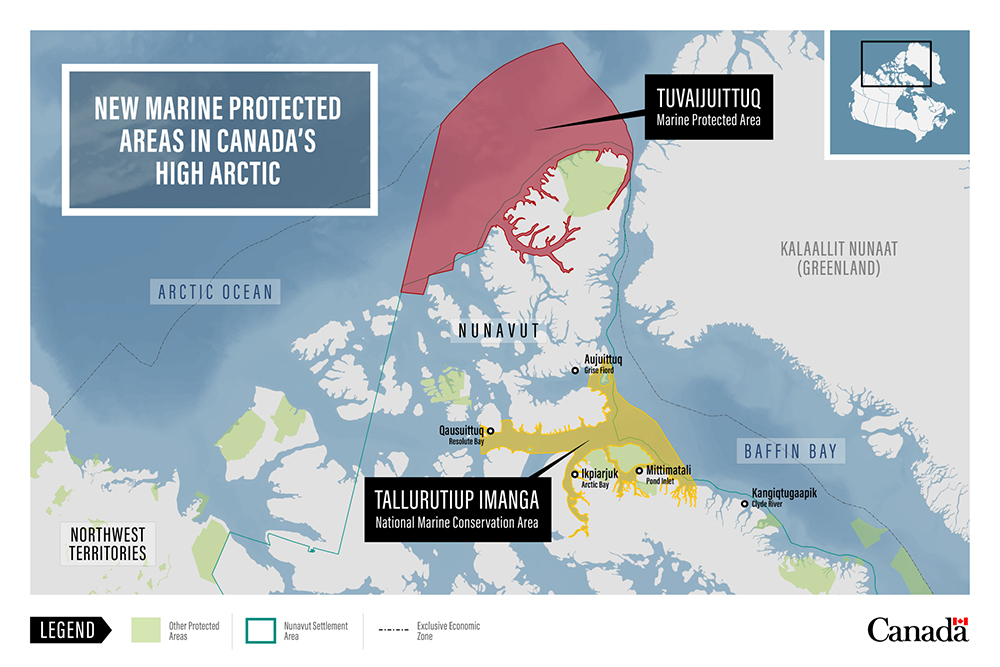View full size image in new tab

New marine protected areas in Canada’s High Arctic — Description of Map
The Government of Canada is working closely with partners to protect the North in a way that recognizes Inuit expertise in land stewardship and their unique relationship with Arctic lands and waters.
Tuvaijuittuq Marine Protected Area
Tuvaijuittuq is located off northern Ellesmere Island in Nunavut. Covering nearly 320,000 square kilometres of ocean, Tuvaijuittuq is a unique area due to the presence of multi-year pack ice. This type of ice is critically important for Arctic under-ice ecosystems and species. As sea ice declines due to climate change this area will become an even more important refuge for ice-dependent species such as walruses, seals, and polar bears.
In April 2019, the Government of Canada, the Government of Nunavut, and the Qikiqtani Inuit Association (QIA) signed a Memorandum of Understanding. They committed to work together to explore how to best protect areas within Tuvaijuittuq, in a way that creates social and economic benefits for Inuit.
Key first steps to establish the Tuvaijuittuq Marine Protected Area (MPA) were taken through regulations published in the Canada Gazette, Part I, on June 22, 2019, launching a 30-day public consultation period. The MPA designation was made through a Ministerial Order under the Oceans Act, which allows for interim protection measures until a permanent designation is made.
Designating Tuvaijuittuq as an MPA helps protect and conserve the important biological diversity, and the unique habitat and ecosystem of this area. It stops any new activity for up to five years while the Government of Canada continues scientific research and extensive consultations with partners, stakeholders, and northern communities. This is the first step to determine long-term protection measures for the area.
Inuit Impact and Benefit Agreement - Tallurutiup Imanga National Marine Conservation Area
In August 2017, the Government of Canada, the Government of Nunavut, and the QIA announced the boundary and interim protection of Tallurutiup Imanga National Marine Conservation Area in Lancaster Sound, Nunavut.
This area is one of the most significant ecological areas in the world. It serves as the primary eastern gateway to the central Arctic for large numbers of migrating marine mammals and birds, and as breeding and foraging grounds for hundreds of thousands of seabirds.
Under the Nunavut Agreement, an Inuit Impact and Benefit Agreement (IIBA) is required before any new protected area can be established in Nunavut. The IIBA outlines the terms and conditions related to a project’s impacts and benefits to Inuit.
On August 1, 2019, the Government of Canada and the QIA signed an IIBA, which established the Tallurutiup Imanga National Marine Conservation Area. This agreement goes beyond this specific area and can cover the requirements for any protected areas established within Canada’s High Arctic Basin.
This agreement includes $55 million in funding to establish a consensus-based Government-Inuit cooperative management board for the conservation area, as well as an Inuit stewardship program managed by QIA in each of the five hamlets in the area—Grise Fiord, Resolute Bay, Arctic Bay, Pond Inlet, and Clyde River.
The Inuit stewardship program will support Inuit-led activities and contribute to the management and operations of the conservation area. Program activities will include monitoring ecological health, maintaining cultural sites, and promoting intergenerational sharing of Indigenous knowledge. They will promote Inuit culture and well-being, and provide economic and social benefits.
Additional Investments through other federal programs
The Government of Canada is making a number of additional investments to provide sustainable, long term economic benefits for the five hamlets in the area. This approach will strengthen collaboration on Arctic marine navigation, explore fisheries potential, support Inuit-led environmental research and monitoring initiatives, and create more opportunities for Inuit training, employment and contracting. As part of this work, the Government of Canada is providing infrastructure investments totaling over $190 million to build multi-use buildings, food processing units, and harbours.

